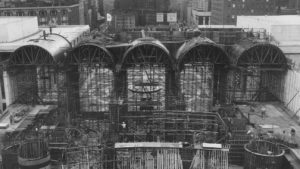
Opera Meets Film: The Opera House [Review]
By Francisco SalazarOpera Meets Film” is a feature dedicated to exploring the way that opera has been employed in cinema. We will select a section or a film in its entirety, highlighting the impact that utilizing the operatic form or sections from an opera can alter our perception of a film that we are viewing. This week’s installment features “The Opera House. “Please note that while maintaining the usual analytical approach we sustain with this section, this article will veer toward being a review of the film as well, similar to our treatment of “Maria by Callas.”
In 2017 the Metropolitan Opera celebrated its 50th anniversary in Lincoln Center. The result was a gala performance that featured some of the world’s greatest stars and some memorable performances. With the celebration came a feature documentary “The Opera House” by acclaimed filmmaker Susan Froemke.
The documentary was essentially a tribute to the famed opera house’s history behind the building of the company’s current Lincoln Center home. In many ways it was a companion piece to the house’s celebration in 2017 and what led to the new Met being built.
From the beginning of the documentary Froemke speaks to numerous administrative heads of the Met that worked at the old building who examine their experiences at the house.They recount how a new Met was being designed all the way back to the early 1920s in Rockefeller Center but the idea was ultimately terminated when the Great Depression hit. And they recount how legendary General Manager Rudolph Bing paved the way to bringing the plans to fruition with the help of Robert Moses and architect Wallace K. Harrison.
What the documentary does so beautifully is implement archival footage with photography that really brings us back to the time and sets the tone for the need for a new opera house. Audiences are shown footage of the old house and its traditional architecture, the lavish gala, and the backstage workings. Some of the most revealing footage comes from backstage showing how the old house’s warehouse was ultimately Ninth avenue and the way the sets were kept outside during snowstorms. For audience members that went to the old Met, they will find reliving the demolishing of the old Met a devastating, emotional ride.
Of course it also great to admire footage of some of the legendary voices of the time and the archival performances the Met has.
But Froemke also steps outside of the opera world and shows the slums of the 1960s and give us a picture of Manhattan in that time period. It is very informative to give us a context of the gentrification of New York and what a new Music establishment meant to the city.
Interviews with two men living in the slums in that period are also revealing and descriptive to what the city looked like in that time period.
Paying Tributes
But as much as the the film is a tribute to the building of the new opera house, it is also a tribute to Rudolph Bing and leading lady Leontyne Price.
Bing is legendary for having been intolerant and for of course firing Maria Callas. But in this film Froemke portrays him as an aristocrat and a true leader. She shows him in meetings problem solving or in rehearsals of “Simon Boccanegra” reciting every line to the singers; it was a well-known fact that Bing knew the music and librettos to every opera he was presenting. The documentary also goes into some of his personal life and shows the manager with his famed dogs.
And then there is Price. The film establishes the legendary soprano from the onset with her memorable final performance of “Aida” at the Metropolitan Opera and then shifts to an interview with the diva. That interview is the heart and soul of the film as it shows the soprano singing excerpts from Barber’s Knoxville 1915 and recounting her debut and then her moments with Franco Corelli as well as rehearsals for the opening of the new Met.
The way Froemke juxtaposes the archival footage of rehearsals from the famed “Antony and Cleopatra” with Price’s interview is simply exquisite. It is also comic to see how Price recounts getting stuck in Franco Zeffirelli’s Pyramid and then showing the footage of the disastrous moment. And to see how Price get emotional as she remembers her days at the Met is something any opera lover will cherish and a testament to the soprano’s love of the theater.
However, the film does have some awkward moments.
The documentary features an interview with Justino Diaz, who opened the Met, yet his interview doesn’t always feel integral to the documentary nor does it explain who he is nor his Metropolitan Opera career. For the most part ever interviewee gets a moment to explain their past but Diaz is edited in to give some context for the opening night.
More awkward are the clips used from “Tristan und Isolde” with Nina Stemme. While it is supposed to make a connection to the beginning of the film, the inclusion of the clip in two instances is haphazard and doesn’t feel integral to the entire picture.
Ultimately, however, these small issues don’t hurt the overall viewing experience and opera lovers will find this to be a moving and emotional film.
Categories
Opera Meets Film

